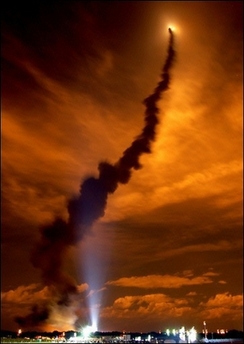
The US Space Shuttle Discovery streaks through the night sky after its launch from the Kennedy Space Center, Florida, with seven international crew members aboard on a mission to the International Space Station. Discovery blasted off on a complex International Space Station mission in the first night launch in four years.(AFP/Ryan Cecile)
Words and Phrases:
streak v.飞跑, 加上条纹
launch n.下水, 汽艇, 发射, 发行
crew n.全体人员, (工作)队
blast vt.爆炸, 毁灭, 使枯萎, 损害
Reference Reading:
NASA readies Discovery launch amid weather worries
by Jean-Louis Santini
Sat Dec 9, 7:35 PM ET
CAPE CANAVERAL, United States (AFP) - NASA readied for a rare night launch of the Space Shuttle Discovery as astronauts boarded amid signs that strong crosswinds were receding.
"At this point everything is definitely looking a lot better," said Bruce Buckingham, a spokesman for the Kennedy Space Center here.
Crosswinds died down and looked "much more favorable," he said less than two hours before the scheduled blastoff.
NASA television showed the crew's five men and two women smiling as they boarded the shuttle in their bulky orange space suits, strapped into their seats and closed the hatch.
Liftoff was scheduled for 8:47 pm Saturday (0147 GMT Sunday). The shuttle must launch within a 10-minute window.
Buckingham said the shuttle's external tank had been filled with two million liters (528,000 gallons) of liquid hydrogen and oxygen.
Weather improved during the afternoon and evening, with crosswinds falling below limits set by the US space agency.
Officials were worried about cold, windy and cloudy weather on Saturday, two days after Discovery's launch was scrubbed at the last minute due to low-flying clouds.
Weather conditions were favorable, however, at two of the shuttle's three emergency landing sites in Europe -- Moron, Spain and Istres, France.
If Saturday's launch is scrubbed, the National Aeronautics and Space Administration will likely try late Sunday, with a 40 percent chance of favorable weather.
A Monday or Tuesday liftoff has a 40 or 60 percent chance, respectively, of launch-worthy weather.
Thursday's plan for the first night launch in four years was scrapped just minutes from ignition because a ceiling of low clouds posed a safety hazard.
Low clouds would pose a visibility risk if the shuttle commander was forced to make an emergency.
The space agency has set a window for rescheduling the liftoff that lasts until December 26, but after December 17 it would have to reprogram the shuttle's computers to adjust to the date change at the end of the year.
After December 26, the Discovery mission would have to wait until mid-January for another chance at liftoff.
Discovery is set to take seven astronauts, including Sweden's first astronaut, on a 12-day mission to the International Space Station.
The astronauts are scheduled to rewire the station's orbiting laboratory and perform other tasks during what NASA has described as the most complex shuttle mission to date.
Crew members will wield robotic arms to install a new truss and get the station's power and thermal systems up and running.
If the launch proceeds as planned, it would be NASA's first night launch since a the Space Shuttle Endeavour in November 2002. Night launches were scrapped as a safety precaution after the February 2003 Columbia disaster.
The three shuttle launches following the Columbia tragedy -- in August 2005 and in July and September 2006 -- were scheduled during daylight hours so that ground and shuttle cameras could closely photograph the spacecraft's exterior tank in case pieces of thermal insulation or ice broke off during liftoff.
A piece of insulating foam damaged Columbia's heat shield shortly after launch, which caused the shuttle to disintegrate upon re-entry into Earth's atmosphere, killing all seven astronauts on board and grounding the shuttle program for more than two years.
Discovery's mission will be the third and final shuttle launch of the year.
NASA has planned 14 shuttle missions -- including this one -- through 2010 to finish building the International Space Station.
Construction on the station is years behind schedule, after long safety-related delays, and the US space agency is in a race to complete the ISS before its aging shuttle fleet is retired in 2010.
One of the astronauts aboard Discovery, American Sunita Williams, will stay behind on the space station.
She will replace German Thomas Reiter of the European Space Agency, who arrived at the space station in July and will return to Earth at the end of Discovery's mission.

